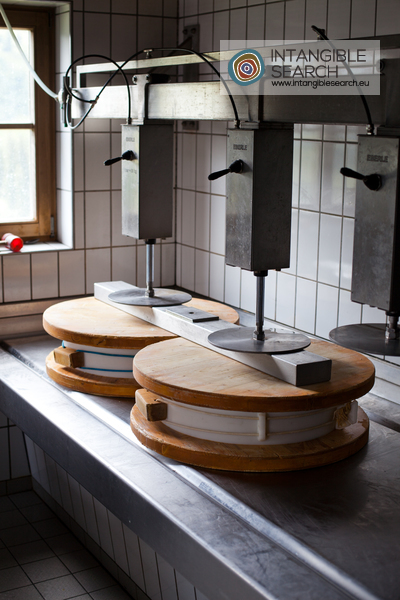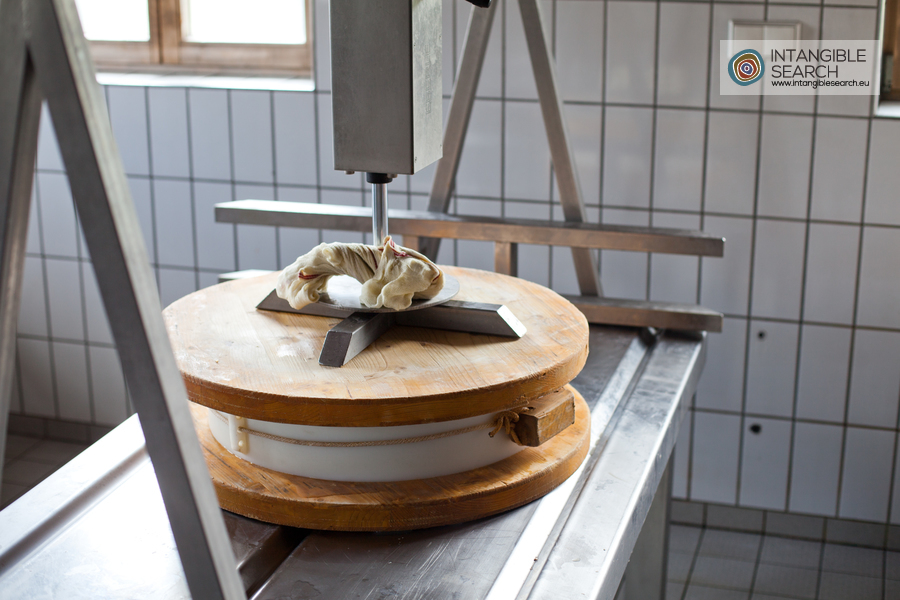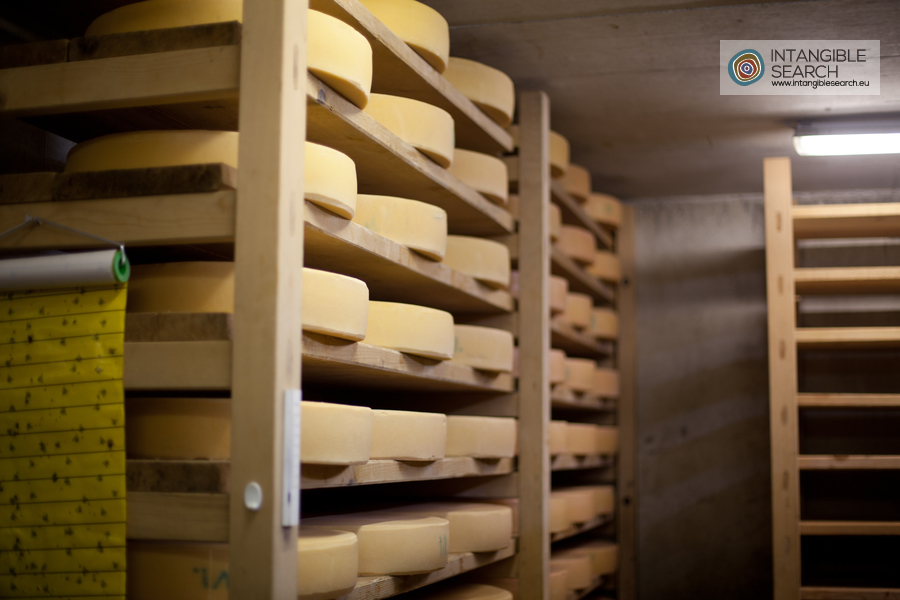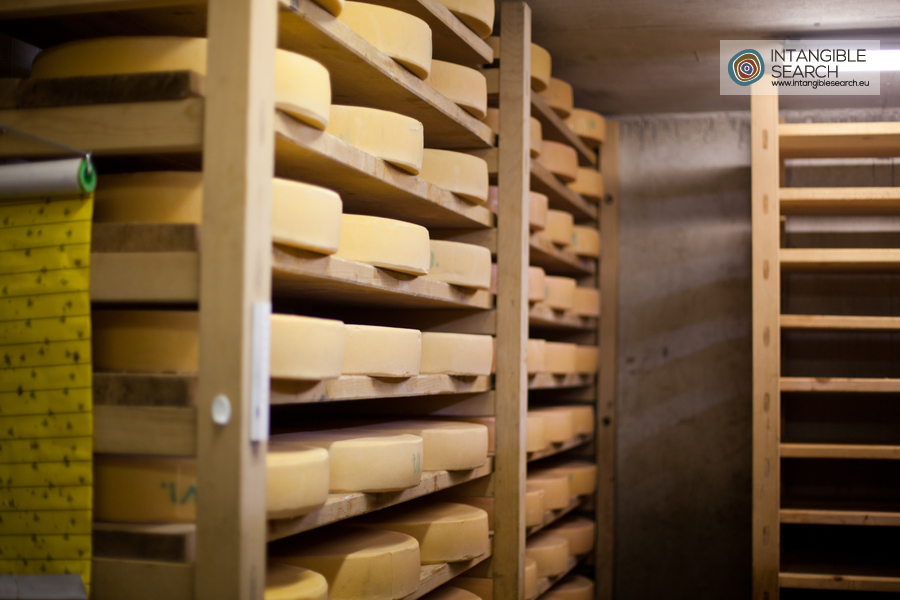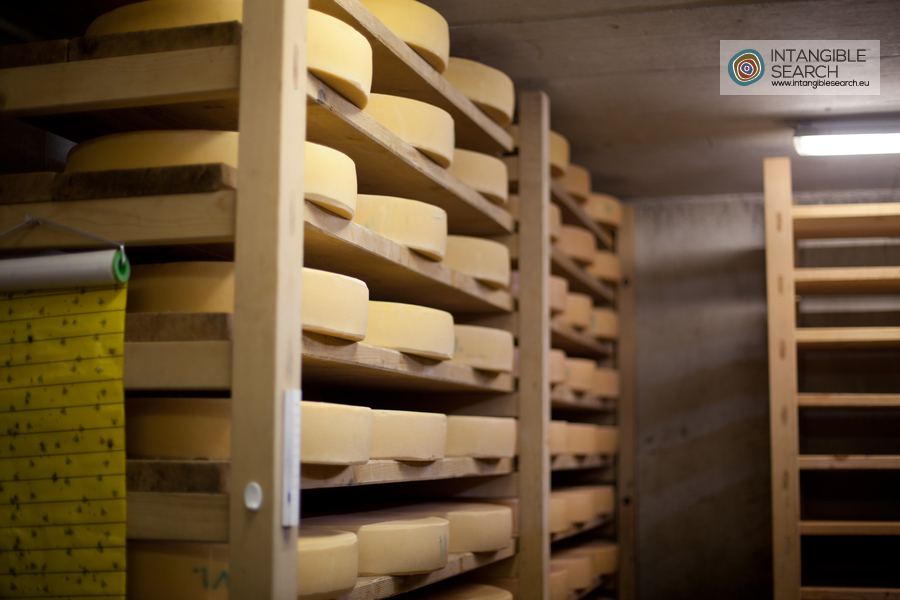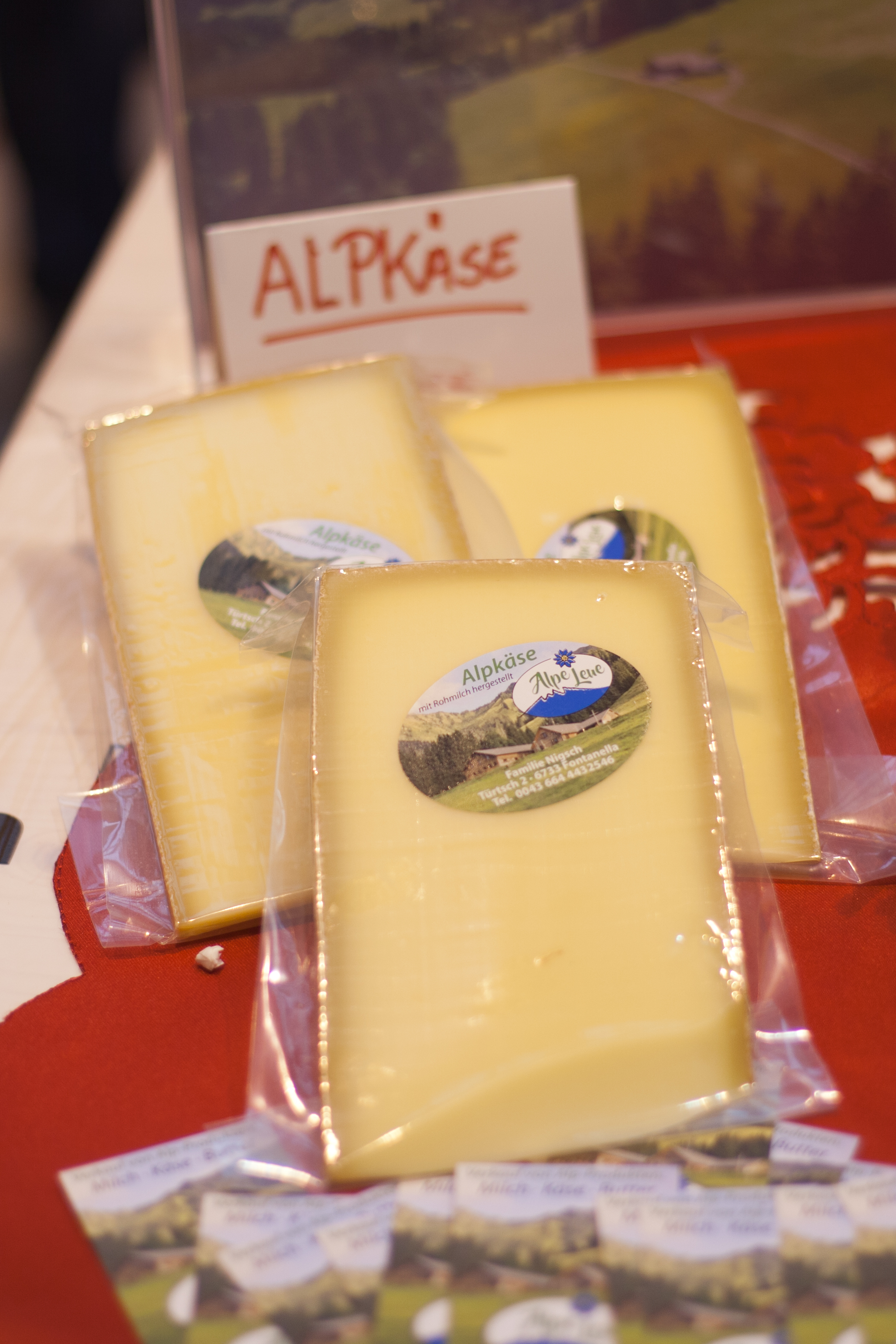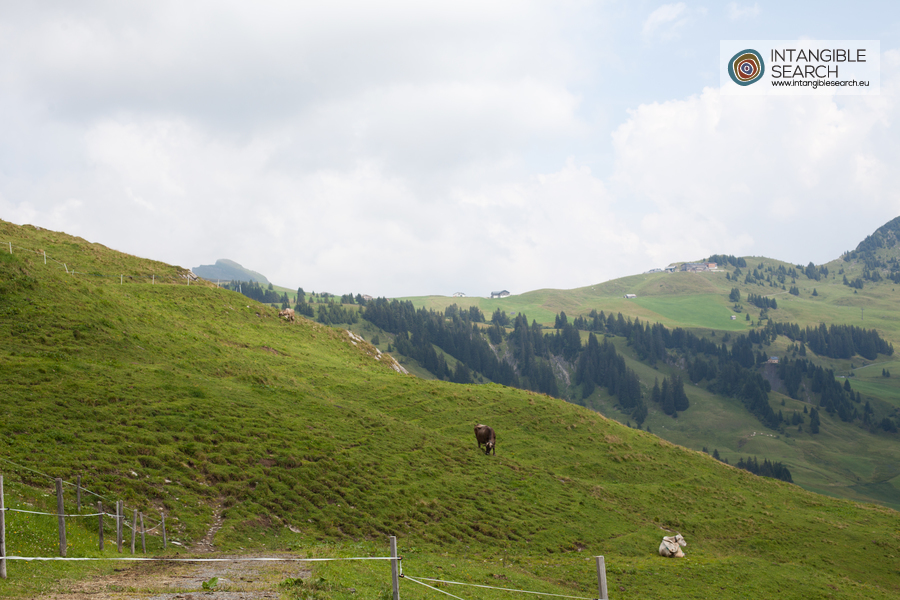Vorarlberger Alpkäse
Vorarlberg, the westernmost province of Austria, is characterized by a strong and distinct cheese culture. In the region, various cheeses are produced, of particular interest is the Alpine cheese. It is - at least in its external representation - closely linked to the so-called 3-stage agriculture practiced in Vorarlberg, especially in the Bregenzerwald region, and registered on the Austrian UNESCO list of intangible cultural heritage.
The 3-stage agriculture in Vorarlberg is a special form of Alpine agriculture, which, in addition to the main farm in the valley, makes use of a "Vorsäß" (also called "Maisäß") and an "Alp" at higher elevations to make up for the limited natural feed supply in the valley regions. In early summer the farmers move their cattle for about four weeks to the Vorsäß and in early July on to the Alp, where they spend the summer. In mid-September the cattle is driven back to the Vorsäß and, after about three weeks, the families move back into their home farms in the valley. In addition to cattle, which make up the majority of the livestock, sheep, goats and occasionally pigs are kept on the mountain pastures.
Vorarlberger Alpkäse is a hard cheese made from untreated raw milk obtained exclusively in the course of summer alpine farming. The addition of milk from the valley is prohibited by the protected designation of origin. Relocated to the model of the 3-stage economy, this means that only milk from the Alp and the Vorsäß pastures is processed. The raw milk is processed directly at the alpine dairy, avoiding both long-term storage and the need for transport.
The milk collected in the evening is stored overnight, the cream is skimmed off the next morning and usually made into butter. The skimmed milk is then, often mixed with freshly milked so-called morning milk, is heated in a copper kettle to just over 30 degrees Celsius, then rennet and cheese cultures are added. After about half an hour, the milk curdles and the resulting curd is then cut up with a cheese harp (a cheese harp resembles an oversized comb). The kettle is heated to about 52 degrees, the curd stirred slowly for half an hour and then lifted from the copper kettle with a cheese cloth. The remaining liquid is known as whey and used for various purposes, (see article on the Alpschwein). The curd itself is pressed into a mold to drain the remaining whey, as it can cause unwanted fermentation during the maturation process of the cheese. The resulting cheese loaf is then stored overnight in the form and becomes firmer. The next day the loaf is lowered into a salt bath, where it lies for three days and which serves to form the rind. Then the cheese is stored for maturation, it is turned every two days and rubbed with salt water.
As the Alpine cheese is produced exclusively at alpine dairies, it is a seasonal product only made during summer time. The Alpkäse differs from the Bergkäse, because it is produced exclusively on alpine pastures. Bergkäse, on the other hand, is also produced in the valley regions and is a type of cheese without indication of its production heritage.
HISTORICAL-ANALYTICAL NOTES
Like many Alpine regions, Vorarlberg has a long tradition of intensive dairy farming because of its geographical conditions. The important role of cheese production can be traced back to late Medieval sources. The records of the Benedictine monastery Mehrerau near Bregenz from 1320 state that the communities in the Vorarlberg Oberland had to deliver between two and eighteen loaves of cheese to the monastery. This was the so-called cheese interest. However, the cheese back then differed significantly from today's Alp cheese. At that time, cheese in Vorarlberg was produced exclusively by the sour cheese method. During this process, raw milk is stored in wooden vats until it turns sour, then the cream is skimmed off. The sour milk thus obtained is heated to room temperature, so that it forms a curd layer on the surface. This curd is removed and stored for maturation. Sour cheese is still produced today in Vorarlberg and known under the regional name "Sura Kees".
The Alp cheese, on the other hand, is a so-called fat cheese. Here not only the curd is processed, but also the fat content of the raw milk. This technology was imported from the Swiss Appenzell to Vorarlberg after the Thirty Years' War. According to records, Paul Baumann from Appenzell, who had settled in Hohenems on the Alpe Schönenmann in 1649, was the first to make fat cheese in Vorarlberg, which was then simply called Swiss cheese. The technique spread among the local farmers, which was eyed critically by the authorities. The administration in Innsbruck, to which Vorarlberg was still subordinate at that time, issued bans on the fat dairy in 1699, 1700 and 1715. It saw the production of fat cheese as a threat to the production of butter and clarified butter. Tax for Vorarlberg communities at that time was paid by delivering ghee to Hall in Tyrol.
The fact that the making of fat cheese has prevailed, and been practiced despite prohibition, might also be a result of difficult climatic conditions of this period (the period from 1675 to 1715 is also called Little Ice Age). Fat cheese can be stored much better than sour cheese, this also meant that cheese no longer needed to be consumed immediately and could be exported and transported over greater distances. After the prohibitions on making fat cheese were repealed in the 18th century, there was an increased influx of farmers from Appenzell, who produced Vorarlberg Alp cheese from then on.
In the 19th century, cheese from Vorarlberg became an increasingly coveted commodity, which was exported to large parts of the Habsburg monarchy, even as far as Hungary. In the second half of the 19th century, the Moosbrugger family, innkeepers and cheese traders, acquired a quasi-monopoly position and controlled trade over long distances. It was the time of the so-called "cheese counts". The most famous among them, Gallus Moosbrugger (1810-1886), found a serious opponent in farmer and writer Franz Michael Felder (1839-1869), who denounced the conditions of the producers and thematized the somewhat exploitative practices of the cheese counts. The profitability of the business is evidenced by the palace of Josef Moosbrugger in Milan. The production was not limited to the Alpe at that time, fat cheese was also made in the valley.
In 1901 the first cheese-making school was founded in Doren in the Bregenzerwald region and consolidated the supremacy of Vorarlberg in cheese production for good. In 1930 the province produced more than half of Austria's total cheese exports. In the 1970s, as part of general modernization trends in agriculture, the cheese production in Vorarlberg also saw substantial changes. The number of dairy cooperatives fell from 120 to 30 during this period. The entry of Austria into the European Union in 1995 was another turning point in the making of Alp cheese. The product was actively positioned as quality food. The manufacturing guidelines now point out that only hay milk can be processed and the cheese may only be produced on the Alp or the Vorsäß.
COMMUNITY
The Vorarlberger Alpkäse is made by several producers, ranging from small to medium-sized companies. It is not a product in the narrow sense, but a mode of production which can result in variations of Vorarlberger Alpkäse. The underlying community is just as heterogeneous. The largest player in terms of production of Vorarlberger Alpkäse is the privately owned Rupp dairy. In addition, there is a large number of smaller cheese dairies and farmers, who also produce Vorarlberger Alpkäse cheese and sell it directly. Some producers joint forces to market their products jointly, especially and early on in the Bregenzerwald region. The " Bregenzerwald Cheese Road " is an affiliation of local producers and organizes joint external communication and exchange within the association.
PROMOTIONAL ACTIONS
The association Bregenzerwald Cheese Road mentioned above regularly organizes events to impart the cheese culture of the region to locals as well as tourists. In addition, the initiative is actively involved in tourism. The "Bregenzerwälder Käsehaus" also introduces visitors to the topic and offers, among other things, a "show dairy", where people can watch the process of cheese making up close.
To sum up, the Vorarlberger Alpkäse cannot be regarded as threatened from an economic point of view, but the related practice of the traditional 3-stage agriculture certainly is.
PROTECTIVE MEASURES
Vorarlberger Alpkäse is a protected designation of origin (Vorarlberger Alpkäse g.U.). In addition, the 3-stage agriculture is part of the Austrian UNESCO list of intangible cultural heritage. The Bregenzerwald region is listed as a so-called Austrian "culinary region" (Genussregion Bregenzerwädler Alpkäse und Bergkäse) by the Federal Ministry for Sustainability and Tourism.
To learn more
Material resources
As mentioned above, Alp cheese is only produced on alps and not in the valley regions. Only unprocessed milk is used, which is gained during the summer months. Apart from various tools (copper kettle, skimmer, cheese harp, cheese cloth and so on), the most important material resource of Alp cheese is the milk and its embeddedness in Alpine agriculture. The supply of milk from valley farms is forbidden in any form whatsoever. Vorarlberg Alp cheese is protected by a registered geographical indication. In the linked document it states: "The basis for feeding the animals is exclusively the Alpine pasture; silage feeding is not permitted." However, the interpretation of this regulation is subject to ongoing controversy. Many farmers also resort to using concentrate on the alps. They argue that the dietary requirement refers to the main feed component and that is still based on grassland use on Alpine pastures. This is also linked to changes in livestock, traditional cattle breeds produced only a fraction of the milk available per animal today by breeding and feeding concentrate. However, these cows need more feed, which is difficult to accomplish with traditional grassland feeding. It is therefore indisputable that the material basis of the Alp cheese making in Vorarlberg is undergoing a process of change that also touches the core of the cultural practice.
Produced by
University of Innsbruck - Institute for Sociology - Clemens Maass
Release Date
03-OCT-2018 (Clemens Maass)
Last update
13-JUN-2019
TweetFrom Community
Tell us about it
